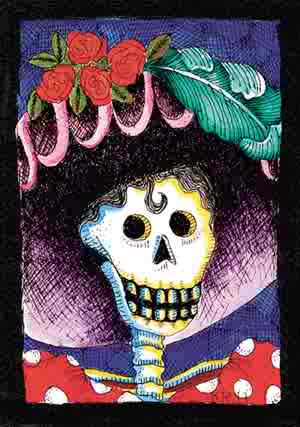
Gretchen Passantino Coburn is a veteran apologist with a long history and body of work. She worked closely with the late Walter Martin and the Christian Research Institute, and has had her own ministry of Answers in Action that she developed with her late husband Bob Passantino. After Bob's passing three years ago the Lord opened up new opportunities for Gretchen, and she is now enjoying newly married life with Pat Coburn. At the 2006 Cornerstone Festival Gretchen presented a series of seminars under the provocative title "Why Doesn't Apologetics Work?" Readers will enjoy the insights of a veteran apologist on this interesting topic.
MoreheadsMusings: Gretchen, please briefly summarize your history of apologetic work for those who may not be aware of your background.
Gretchen: My late husband Bob began as an apologist for skepticism as a teenager, before he became a Christian (and before we met). He was in southern California, the hotbed of the Jesus Movement, and in 1968 or so, he used to research arguments against Christianity, the Bible, and God in the library (although he didn't do homework for school), and then head down to the beach where the "Jesus Freaks" were witnessing to all the LSD hippies near the Huntington Beach Pier. As they would stroll the sand with their cartoon tracts, he would follow with his Robert Ingersoll and Bertrand Russell arguments. So apologetics came naturally to him when he later became a Christian. When we met, I was going to UC Irvine, majoring in Comparative Literature, and working at a Christian bookstore. Bob visited the bookstore and was always interested in the musty, thick, dense theology books, not the screaming testimony and rapture books. That intrigued me, since I had a lot of time on my hands at the store, and had kept my mind occupied by reading those same old books. Conversations and 10% sales discounts led to Bible studies and to witnessing together to anyone who would listen -- including Jehovah's Witnesses and Mormons. That's how we ran across the late Walter Martin and had the blessing of meeting him and volunteering to help him when he was speaking in California. When he first moved to California in 1974, he conducted Bob's and my wedding and then hired me to help him open the Christian Research Institute in California. Concurrently, we joined with some of our Jesus Freak friends and started a lay ministry to Jehovah's Witnesses called Christian Apologetics: Research & Information Service (CARIS).
After our first child was born in 1978, I quite my employment at CRI and focused on motherhood, CARIS, and free lance work for other Christians, including continuing to help Walter Martin with his book projects until his death in 1989. In 1985, Bob and I incorporated Answers In Action to reflect our broader commitment not only to general apologetics, but also to active apologetics; that is, endeavoring to unite the reasons, arguments, and evidence of rational apologetics with the persuasion, relationship, and discipleship of more missions oriented apologetics. For many years we worked together in apologetics. Although many know us for our many books, articles, and other materials (most available on our website, (http://www.answers.org/), we also believed that the heart of our ministry was in relationships. We developed strong mentoring relationships over the years and became known to those in our field for our commitment to helping more visible leaders behind the scenes. We have been blessed over the years to help -- and be helped by -- people like Norman Geisler, Lee Strobel, H. Wayne House, Mark Mittleberg, Greg Koukl, Rick Warren, Bill Hybels, Josh McDowell, Hank Hanegraaff, and so many others. In addition, we always made time for people in personal relationships.
Bob was the master of the phone, sometimes talking to 10-20 people in a day, and long, philosophical conversations with each one. I got very good at cooking dinner for 20 and answering Bible questions at the same time. But it's the behind-the-scenes mentoring and the personal discipleship that always motivated us. Also through the years I was privileged to teach as an adjunct for Biola University and Concordia University, and Bob and I together spoke in many colleges, seminaries, and on hundreds of radio and television programs. Just a few years before Bob died in November of 2003, Dr. Michael Adams and Dr. H. Wayne House of Faith Evangelical Lutheran Seminary approached us about advancing our education. When we started out, there were no schools that offered degrees in apologetics, and the only way to become a professional apologist was to apprentice under one, like we did first with Walter Martin and then with others. One issue that was always important to Bob was that God's Word and the things of the mind are available to anyone, not just to elite academicians. He was never very successful in school and he knew that his success in apologetics, philosophy, and theology was a strong encouragement to others who did not do well in formal school settings. But by the end of the millennium, there were so many good programs available (such as Talbot Theological School's M.A. in Apologetics Program) on the graduate and undergraduate level, that our lack of graduate degrees was needless. So, we worked out a study program for Bob to complete his undergraduate degree and for the two of us to complete Masters of Divinity degrees with an emphasis in apologetics. Since our graduation, I have taught for Faith Seminary as an adjunct here in southern California and have been able to mentor a number of students through the entire program. Every time I get to stand up for one of my graduating students, I am so thankful that the torch is being passed on. Since Bob's death, I have continued to run Answers In Action with the strong support of our Board of Directors and our volunteers. Although I can't manage 20 phone calls a day or all-night philosophical debates, God has graciously prospered the ministry and our ability to reach out in meaningful ways that truly put answers into action. I am expecially excited about the ground-breaking research I am doing to develop a peer mentoring program for law enforcement professionals. I know Bob would be so enthusiastic about this. If we can figure out how to translate the truths of the Christian faith into a practical discipleship program for some of the most cynical, skeptical, action-oriented men and women who encounter the reality of good and evil every single day, then we can reach just about anybody.
On a personal note, in August of 2005 I remarried after God reunited me with the man, Pat Coburn, who had been my first boyfriend when I was a teenager. We had lost complete contact for 34 years, but now united in Christ and in love we're asking God for 34 years more together serving Christ.
MoreheadsMusings: At Cornerstone Festival you recently presented a series of talks on "Why Doesn't ApologeticsWork." Can you summarize your thesis?
Gretchen: If we as apologists are not willing to be self-reflective, objective about our strengths and weaknesses, and enthusiastic about continually adapting what we do to the unique audiences God brings us before, then we will fail at a calling that is second only to the preaching of the gospel. And often people will not listen to the preaching of the gospel until their objections and misunderstandings are dealt with, which is the provenance of apologetics.
MoreheadsMusings: For those familiar with your work this might seem like not only a provocative title, but also a strange topic for you. What influences have led you to this type of thinking?
Gretchen: Never in American Evangelicalism have we had more wealth of arguments, evidence, and reasons for faith, and yet we are having less and less influence in the world around us as we increasingly fail to communicate and persuade a community (both within and without the church) that not only doesn't understand what we're saying, but doesn't even know why they should care. As apologists, we're always quick to have the answers and give the lectures, but I've disciplined myself to spend more time listening, watching, and asking questions with those I hope to minister to than I do "practicing apologetics." That has demonstrated to me over and over that we must continuously evaluate and modify our delivery (not the timeless core of the Word of God) or we will fail in our calling. I hope some of the ideas and questions I raised at Cornerstone will help in that regard.
MoreheadsMusings: It's easy to be misunderstood when speaking on topics in which people invest a lot emotionally. In order to make sure you're not understood, you're not saying we should not engage in rational apologetics and offer good arguments and evidences for the faith. In the interests of clarity, what are you saying?
Gretchen: No, but what I'm saying is that if we apologists don't become at least as critical about ourselves and our own methodology as we do about those we disagree with, we will be failing the Lord who called us to this profession. We are not exempt from human fallibility and sinfulness just because we've always got an answer and an argument. We are as susceptible to cultural bias, ignorance, spiritual elitism, euphemistic language, esoteric vocabulary, social ostracism, and egoism as any televangelist, social gospel proponent, or guru we so smugly denounce. As apologists, we tend to enjoy arguments, approach choices logically, and draw distinctions. Those are neither good nor bad traits in themselves. But when we cling to arguments instead of relationships, or use logic to the exclusion of heartfelt-empathy, or draw a false line on the basis of our preferences rather than the essentials of the gospel, we are wrong and if we continue without heeding God's admonition, we are sinning. Let me give you an example: Someone e-mailed me today and complained that his post on abortion had been unfairly banned by the discussion group moderator because he used the word "evil," and that was deemed "inflammatory." Now as apologists, we immediately think about how we can protest the censorship and force the group to post our comments and face the facts. If his purpose was to demand civil rights for all discussion posts, then I guess that's what he should push for. But I suggested something else. If, instead, his purpose had been to warn people of the dangers of abortion and to encourage them to protect even unborn life, then he should re-word his post to meet the vocabulary standards but still communicate his concern and respect for life. I don't see that as compromise, or diluting the gospel. I see that as strategy.
MoreheadsMusings: Let's talk a little more about the importance of relationships. There is some good evidence in the history of the Christian church about the importance of relationships and community to evangelism, as evidenced in Celtic Christianity for example. There's also good evidence from the social sciences that early Christianity traveled most effectively along social networks. We seem to have forgotten these simple truths in our time. Why do you think that is, and how might those inclined toward a more traditional apologetic incorporate these important elements?
Gretchen: I think part of the reason apologetics is so popular in American Protestant Evangelicalism of the 21st century is because we are largely a culture of words, not of relationships. And yet, it is by relationships that lives are changed. This is incredibly biblical, but incredibly missed by many of us as apologists. In fact, one could have all the reasons, answers, and arguments that Jesus Christ is Lord, but unless we have that relationship with Him by the power of the Holy Spirit, we don't have eternal life! If we would remember this simple core gospel principle in everything we do, we as apologists would be incredibly more effective & far easier to live with! Here's an example. I was speaking on women in church history and after my talk a young missionary asked my advice. She and her friends were involved in church planting in a very religiously conservative area of the Middle East. The men who had converted from Islam to Christianity were adamant that women could not have any visible or teaching position in the church at all. She wanted arguments to convince them that she and her friends, all long-time Christians and graduates of Bible college, could teach Bible studies better than the men who were not only recent converts and not biblically trained, but actually illiterate. She asked an apologetics question that really needed a relationship answer. I asked her to try an experiment. In her next 6 month tour in the Middle East, I asked her to not argue with the men anymore, but to enthusiastically live her life for Christ, and eagerly participate in anything the men would allow her to do. If she were persistently available and Christlike, I was convinced she would have far greater influence for the gospel than if she continued arguing with them.
MoreheadsMusings: As you talk about relationships and building credibility with our hearers I am reminded that your ideas seem to fit well within an overal missional paradigm. That is, the mission of the church in the world is central to the life of the church, and the history of Christian mission in cross-cultural contexts includes a variety of aspects including relationships, cross-cultural communication, and culturally contextualized apologetics. Would you say that your current views on apologetics recognizes its supporting role in a broader context of evangelism and missions?
Gretchen: I don't think my views on apologetics currently are contrary to my views before, and in fact Bob and I had many long discussions on these very issues; and this emphasis is why we never focused on a public platform ministry or devoted most of our time to writing rather than relating. However, I do believe that as our culture has changed and as we have developed a good body of apologetics material and methodology from those of us who are "professional" apologists, we have not only prepared the way to integrate apologetics seamlessly into an overal missions or evangelism approach for lay people throughout the church; I predict that if we as apologists don't recognize that symbiotic relationship and the need for every Christian to incorporate reasons with relationships, we will become largely irrelevant to the church as a whole, the immeasurable value of what we have accomplished will be lost to the church, and we will have unwittingly weakened the church's ability to overcome the world. I would love to see professional apologetics disappear from American Protestant Evangelicalism, not because it has been aborted, but because it has joined with the seed of the gospel to give life to the Body of Christ.
MoreheadsMusings: Is there anything else you'd like to say, particularly to those of a more traditional apologetic orientation?
Gretchen: I don't like to see a schism between the "traditional" and the "missiological" apologists. I think Christians are better at fighting among themselves than any group including sports fans from opposing teams and fanatical Muslim sects. And I think apologists are supreme within the Church for devouring each other. That may seem sensationalistic or extreme, but I think it's true. If we spent just as much time listening to each other as criticizing, working together as being in opposition, enjoying our differing perspectives as condemning our differences, and understanding as arguing, we would be an unstoppable force for the gospel in a dying world.In the last few years, I have spent a lot of time "listening" to apologists of all kinds. (Listening means both literally in conversations and also reading and corresponding in print or electronically.) I have not tried to argue or persuade, but I have tried to listen and understand. Both sides, in my opinion, have at times expressed unhelpful dogmatism, eltism, paranoia, argumentiveness, judgmentalism, and intolerance. If I were to give a running score, I would say those on the traditional end of the spectrum are ahead in that regard, but the missiological end is close behind. Shame on us! There shouldn't be "two sides" -- we should be accommodating enough (not compromising essentials) to provide a united experience of the best apologetics along the spectrum without rancor or envy.I offer myself as a conduit for open, humble, loving communication among any apologists of whatever stripe who would truly like to join us all together to serve Christ.
[After reflections on the few comments posted to this interview I have decided to delete them so as to preserve the spirit within Gretchen's comments.]







